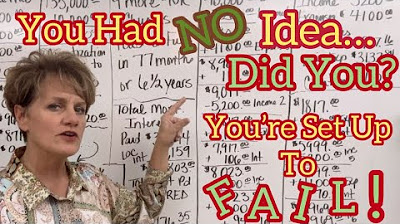How I Automate My Finances
Summary
TLDRIn this video, Thomas Frank discusses the power of automating your personal finances to save and invest consistently over time. He shares how he automated bill payments, credit card payments, retirement contributions, and investing deposits early on, allowing him to accrue over $300k in investments. Thomas emphasizes establishing a one month cash buffer first before automating to avoid overdrafts. He then walks through how to set up auto-pay for bills and credit cards, make 401k contributions directly from your paycheck, and arrange recurring transfers into investment accounts. Thomas stresses the importance of still manually reviewing your finances monthly when relying on automation.
Takeaways
- 💰 The habit of financial automation significantly contributed to saving $300,000 in investment accounts over 10 years.
- 🚀 Automating finances involves using software to manage financial tasks like bill payments and investments to meet financial goals.
- 📊 Financial automation ensures consistency in savings and investments, potentially leading to substantial growth over time.
- 💳 Starting with a small monthly investment can grow significantly through the power of compound interest and consistent contributions.
- 💸 Establishing a one-month cash buffer is crucial before automating finances to avoid overdrawing accounts.
- 💻 Utilizing bill automation for regular payments prevents missed payments and aids in maintaining a good credit score.
- 💱 Viewing credit cards as pass-through vehicles for existing funds, not for accessing credit, can avoid interest charges and build credit.
- 💵 Setting up automatic investments in retirement accounts like 401(K)s, especially with company matching, maximizes savings.
- 🔧 Regular monthly financial reviews ensure you stay informed about your financial health and the performance of automated systems.
- 📱 Exclusive content and in-depth financial planning strategies are shared on platforms like Nebula, complementing YouTube videos.
Q & A
What is the main topic Thomas discusses in this video?
-The main topic is financial automation - setting up automatic transfers and payments to simplify personal finance management.
What is the key financial habit that allowed Thomas to save $300,000 over 10 years?
-The key habit was setting up automatic monthly investments from an early age, which compounded over time due to market growth.
What are some benefits of automating your finances?
-Benefits include: ensuring bills and debts get paid on time even if you forget, increased consistency in investing leading to higher long-term returns, and greater peace of mind.
What should you have before starting to automate finances?
-Thomas recommends having at least a 1 month cash buffer saved as an emergency fund, so automatic payments don't overdraw your accounts.
How does Thomas use credit cards?
-Thomas uses credit cards only as a pass-through for expenses he was already going to pay for in cash. He pays the full balance each month and does not carry debt.
What two habits does Thomas recommend in addition to automation?
-1) Putting all bill due dates on your calendar. 2) Doing a monthly review of all accounts to stayon top of your finances.
Whatspreadsheet does Thomas use for financial planning?
-Thomas created a custom spreadsheet with formulas to calculate his average income, expenses, savings goals, taxes etc. He made it into a free downloadable template.
What is Nebula?
-Nebula is an ad-free streaming platform created by Thomas and other educational YouTubers, with exclusive content. It comes bundled with CuriosityStream documentaries.
What is the CuriosityStream documentary Thomas recommends?
-Thomas recommends "The Ascent of Money" which looks at the history and development of money over time.
How can you access Nebula and CuriosityStream at a discount?
-You can get Nebula and CuriosityStream for a year for less than $12 by going to curiositystream.com/thomas and signing up.
Outlines

Dieser Bereich ist nur für Premium-Benutzer verfügbar. Bitte führen Sie ein Upgrade durch, um auf diesen Abschnitt zuzugreifen.
Upgrade durchführenMindmap

Dieser Bereich ist nur für Premium-Benutzer verfügbar. Bitte führen Sie ein Upgrade durch, um auf diesen Abschnitt zuzugreifen.
Upgrade durchführenKeywords

Dieser Bereich ist nur für Premium-Benutzer verfügbar. Bitte führen Sie ein Upgrade durch, um auf diesen Abschnitt zuzugreifen.
Upgrade durchführenHighlights

Dieser Bereich ist nur für Premium-Benutzer verfügbar. Bitte führen Sie ein Upgrade durch, um auf diesen Abschnitt zuzugreifen.
Upgrade durchführenTranscripts

Dieser Bereich ist nur für Premium-Benutzer verfügbar. Bitte führen Sie ein Upgrade durch, um auf diesen Abschnitt zuzugreifen.
Upgrade durchführenWeitere ähnliche Videos ansehen
5.0 / 5 (0 votes)






